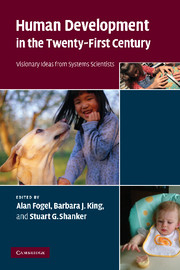Book contents
- Frontmatter
- Contents
- List of contributors
- Introduction: Why a dynamic systems approach to fostering human development?
- Part I Dynamic relationships between genetics and environments
- Part II The dynamic system of the child in the family
- Part III The dynamic system of the child in social and physical environment
- 10 The tempest: anthropology and human development
- 11 An anthropology of human development: what difference does it make?
- 12 The social child
- 13 Learning about human development from a study of educational failure
- 14 Dynamic views of education
- 15 Embodied communication in non-human animals
- 16 Children in the living world: why animals matter for children's development
- Part IV Dynamic systems approaches to mental health
- Part V Conclusions and outlook
- Index
- References
14 - Dynamic views of education
Published online by Cambridge University Press: 22 September 2009
- Frontmatter
- Contents
- List of contributors
- Introduction: Why a dynamic systems approach to fostering human development?
- Part I Dynamic relationships between genetics and environments
- Part II The dynamic system of the child in the family
- Part III The dynamic system of the child in social and physical environment
- 10 The tempest: anthropology and human development
- 11 An anthropology of human development: what difference does it make?
- 12 The social child
- 13 Learning about human development from a study of educational failure
- 14 Dynamic views of education
- 15 Embodied communication in non-human animals
- 16 Children in the living world: why animals matter for children's development
- Part IV Dynamic systems approaches to mental health
- Part V Conclusions and outlook
- Index
- References
Summary
A Navajo medicine man of great age and wisdom was asked to relate the story of how children were taught in the old ways to find knowledge, purpose in life, and harmony with nature. He spoke of the teachings of the elders about daily running to the East to greet the dawn with prayers.
He runs races early in the mornings. He takes snow baths and ice water plunges in the winter. He is advised to run as far as he could and back and to yell at the top of his voice as he runs to develop strong lungs and a loud voice. He must blow all the evil things out of his system, like cheating, hate, stealing, jealousy, greed, and lying. He must inhale the good clean air that comes with the dawn in long deep breaths, which is like taking in good health, prosperous life, and harmony with beauty. These are the teachings of the elders and we did what they told us to do. When one sleeps until sunrise, his voice will not be heard. If he yells into the early dawn like the coyote, you will have a strong voice to sing loud and clear without getting out of breath. This is so true because I still have a strong voice at my age and can sing all night yet.
His account is a life story about connections among all levels of experience – physical, mental, and spiritual.
- Type
- Chapter
- Information
- Human Development in the Twenty-First CenturyVisionary Ideas from Systems Scientists, pp. 128 - 135Publisher: Cambridge University PressPrint publication year: 2007

